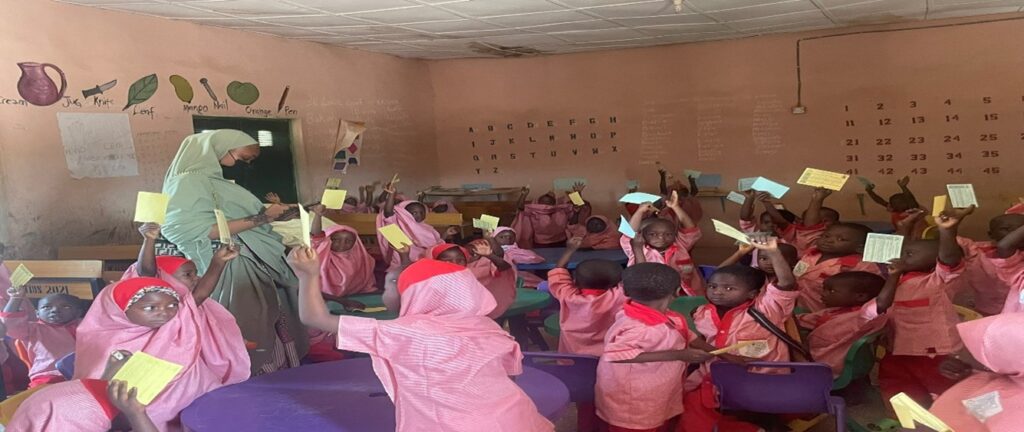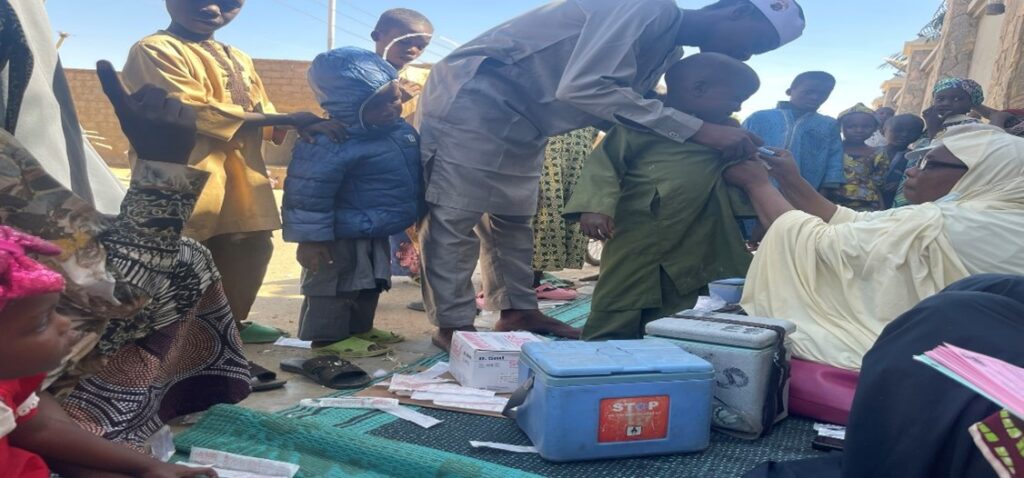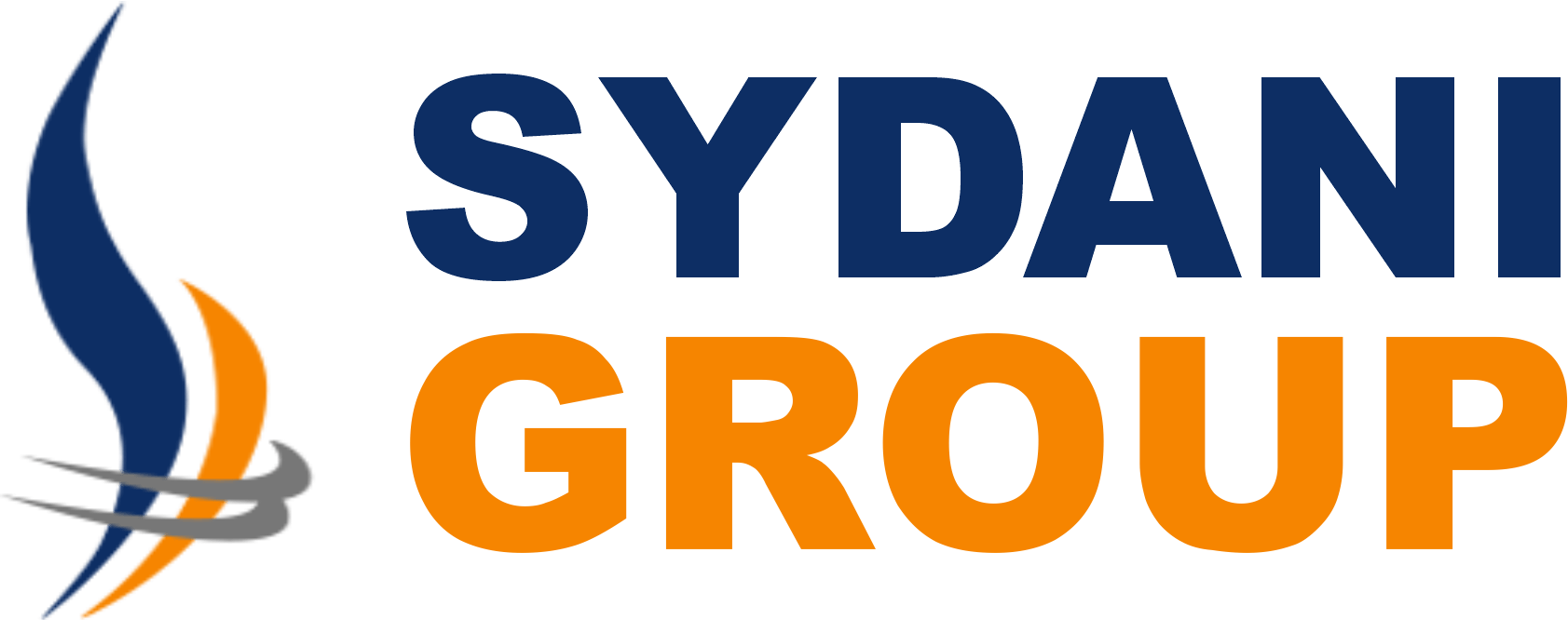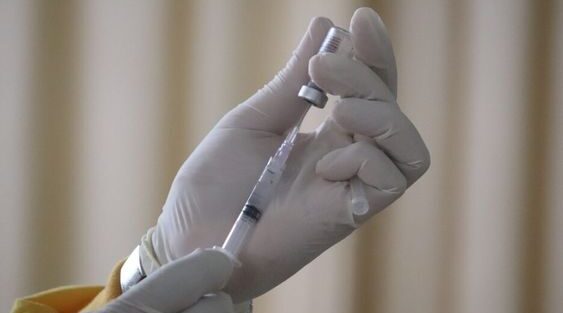Emmanuella Nzeribe, Daradara Kubura, Adachi Ekeh, Olugbemisola Samuel
Overview
Measles remains one of the most common vaccine preventable childhood killer diseases, particularly among children younger than 5 years in sub-Saharan Africa, the Middle East, and Southeast Asian regions.123 Statistics have shown that about 75% of all new global cases of measles occurred in Africa in 2022.4 With the disruption in the immunization program caused by the COVID-19 pandemic in 2020, about 33 million children missed their complete doses, and in the year 2022, these children were found to live in 4 Southeast Asian countries and 6 African countries, of which Nigeria is part.5
Figure 1: During the Supplementary immunization activity in one of the participating states. Photo credit: The Sydani MCV-SIA Project team
Situational Analysis
Nigeria introduced measles vaccination into the routine immunization schedule in 1978 for children aged 9 months and in 2006, the case-based measles surveillance to track measles cases was initiated6. The tracking was done through the establishment of four serological laboratories across the country, to test all suspected cases of measles for IgMi measles antibodies. In 2011, Nigeria adopted the 2020 elimination goal with the aim of reducing measles incidence to less than one case per one million children and achieve 95% measles immunization coverage at both national and local government levels7. In accordance with the WHO and UNICEF annual vaccine coverage (WUENIC), MCV1ii and MCV2iii coverage in Nigeria was 58% and 9% in 2019, while in 2022, the MCV1 and MCV2 was 60% and 38% respectively.Measles elimination requires achieving and maintaining high levels of population immunity. Measles vaccination coverage will need to reach and remain at or exceed 95% with each of the two doses of MCV at the LGA/State and national levels. Nigeria is set to eliminate measles by 2030 and has developed a strategic plan based on the WHO Measles and Rubella strategic framework with clear objectives focusing on improving routine immunization coverage and preparedness, and response to measles outbreaks. The strategies for the first objective (routine immunization) include implementing innovative and evidence-driven interventions to enhance routine immunization coverage, reach the unreached populations through high-quality routine services and periodic Supplementary Immunization Activities (SIAs).
The SIAs strategy of periodic nationwide mass vaccination campaigns were introduced to ensure that children missed during routine immunization services are given the opportunity to get vaccinated. The measles SIAs one-time catch-up campaign targeting children aged 9 months to 14 years was conducted in 2005/2006 in Nigeria, followed by periodic follow-up campaigns conducted every 2–4 years to target children who were born after the previous immunization activity8. Although, the country recorded some level of relative progress in measles coverage in the past few years, it is important to know that this is not sufficient to achieve the goal of 95% measles coverage vaccination by 2030, therefore, there is the need for the strengthening of routine immunization services and SIAs across the primary healthcare levels in Nigeria9. According to the 2021 MICS/NICS reportiv, only 60% of children aged 12 to 23 months have received the first dose and 16% of children aged 24 to 35 months received the second dose of measles vaccine10. Systemic challenges in improving vaccination coverage have hindered progress, in addition to the COVID-19 pandemic, which further exacerbated the situation by disrupting routine immunization services.

Figure 2: A picture of the vaccinated children with their vaccination cards in one of the participating states. Photo credit: The Sydani MCV-SIA Project team.
Intervention
The NPHCDAv set the target of achieving 95% measles vaccination coverage and 85% measles coverage of zero-dose children based on the post campaign coverage survey (PCCS) in participating states during the 2023 measles vaccination campaigns. Sydani Group was contracted by the Bill and Melinda Gates Foundation to deploy targeted interventions to address the identified gaps with a focus on the zero dose LGAs. This was done by strengthening the existing coordination structure for optimized vaccination coverage, facilitating national and sub-national comprehensive planning, provision of technical and supervisory support personnels, as well as facilitating the post campaign recommendations to ensure successful implementation. The team utilized the PRRSM strategy (Plan, Reach, Report real time, Sweep and Mop up) to establish quality measures aimed at optimizing the implementation of the MCV-SIAs project in the supported states.
The 2023 MCV-SIAsvi campaign was conducted in 13 states in Nigeria. Sydani Group deployed targeted interventions in the eight Northern states with zero dose LGAs (Taraba, Yobe, Kebbi, Borno, Kano, Katsina, Kaduna, and Sokoto) while we provided technical assistance in the remaining five states (Abia, Bayelsa, Ebonyi, Imo, and Kwara). At the national level the Sydani team supported the planning and coordination activities, developed a database for vaccinators and drafted terms of engagement for the vaccination team members to sign. At the state level, Sydani Group engaged TAsvii in supporting planning and coordination activities to ensure the successful implementation of the campaign.
At the Local government level, we recruited, trained, and deployed management support technicians (MSTs) to provide technical support to LGA officers and conducted supportive supervision to the vaccination teams. At the community level, we recruited independent observers who were rotated as part of the vaccination team collecting real time data on children vaccinated in the zero-dose communities. The sweep agents who were residents in each settlement were recruited and trained on real time data collection. They were to sweep each settlement (house to house) visited by a vaccination team to identify and report all missed children. This contrasts with the regular rapid convenience monitoring (RCM) where 10 houses were sampled in a settlement. The data gotten from the sweep agents informed the targeted mop-up activity during and after the campaign. The house-to-house activities of the sweep agents also created awareness on the measles campaign. Sydani Group also funded an extended mop-up vaccination in wards with less than 95% coverage (using administrative data) across the 13 states.
Achievements
The post campaign coverage survey (PCCS) results showed a weighted average of 87% MCV coverage across the 13 implementing states with the 8 states with zero dose LGAs supported by Sydani outperforming the others. This can be attributed to the strategies that were incorporated to ensure improved campaign quality which included the validation of settlement covered using the daily implementation plan (DIP), the attachment of independent observers to ensure real time visibility of data and ensure geographic coverage as well as the sweep agents who identified the missed children for mop up vaccination. The states with zero dose LGAs were the primary focus for most of the interventions deployed by Sydani Group to optimize the MCV campaign and reduce the zero-dose burden in the country.
The real-time data collected by Sydani Group showed that 90% of planned settlements in the DIP were reached at all the zero dose locations in the 8 focused states. The PCCS results showed an unweighted average of 90% in the 8 focused states and then 86% in the remaining 5 states where only technical assistants were provided. It is worth noting that Taraba and Yobe states exceeded the benchmark of 95% coverage having a result of 99% and 98% respectively. The other states that did not reach the benchmark performed better than what was seen in 2021 except for Sokoto state. Sokoto state declined to participate in the extended mop-up activity that Sydani Group funded.

Figure 3: A picture of the mop-up campaign. Photo credit: The Sydani MCV-SIA Project team.
Challenges
The challenge of security was mitigated by the Sydani team through the collaboration with the local vigilante groups and ‘hit and run’ teams to ensure that those areas were visited, while the extremely security compromised areas were not visited at all. Some settlements that were in the micro plan were non-existent due to desertion because of insecurity. There were also cases of non-compliance whereby more advocacy was given to community leaders and local champions to convince caregivers on the importance of the measles vaccines for their wards. The bandits in some LGAs in Katsina and Sokoto states refused the use of Android phones by the independent observers, so they had to enter the data manually and enter on their androids when they returned after the day’s work.
Conclusion
The PRRSM (plan, reach, report real-time, sweep and mop-up) strategy was a novel strategy that addressed a lot of gaps seen in previous campaigns; the lack of visibility into the vaccination teams work, the lack of settlement geographic coverage and the validation of data coming from the vaccination teams (house to house identification of missed children). In as much as the goal for the campaign is to have high coverage, we still do not want to forget the real impact which is to reduce the incidence and outbreak of measles in the country. By strengthening routine immunization, enhancing surveillance, and promoting community awareness, Nigeria is on her way to eliminate measles in the coming years.
For further information, please contact: SIRI@sydani.org
References
[1] Bagcchi, S. (2021). Measles immunization gaps in Africa. The Lancet Infectious Diseases, 21(7), 918.
[2] Thapa A, Khanal S, Sharapov U, Swezy V, Sedai T, Dabbagh A, Rota P, Goodson JL, McFarland J; Centers for Disease Control (CDC). Progress toward Measles elimination – South-East Asia Region, 2003-2013. MMWR 2015 Jun 12;64(22):613-7.
[3] Wang, R., Jing, W., Liu, M., & Liu, J. (2022). Trends of the global, regional, and national incidence of measles, vaccine coverage, and risk factors in 204 countries from 1990 to 2019. Frontiers in medicine, 8, 798031.
[4] Minta AA, Ferrari M, Antoni S, Allison Portnoy, Alyssa Sbarra, Brian Lambert, Sarah Hauryski, et al. Progress toward regional measles elimination—worldwide, 2000–2021. MMWR Morb Mortal Wkly Rep 2022;71: 1489–95. https://doi.org/10.15585/mmwr.mm7147a1
[5] World Health Organization and U.S. Centers for Disease Control and Prevention (2023). Global measles threat continues to grow as another year passes with millions of children unvaccinated. Accessed on 11th March, 2024. Available at https://www.who.int/news/item/16-11-2023-global-measles-threat-continues-to-grow-as-another-year-passes-with-millions-of-children-unvaccinated
[6] WHO/UNICEF 2017. Nigeria: WHO and UNICEF estimates of immunization coverage: 2017 revision Indonesia: WHO and UNICEF estimates of immunization coverage: 2017 revision 2019;1–17.
[7] Masresha B, Braka F, Onwu NU, Oteri J, Erbeto T, Oladele S, Sumaili K, Aman-Oloniyo A, Katsande R, Tegegn SG, Fall A. Progress Towards Measles Elimination in Nigeria: 2012 – 2016. Journal of Immunological Sciences. 2018 Aug 2;Suppl:135-139.
[8] Ferrari, M. J., Grais, R. F., Bharti, N., Conlan, A. J., Bjørnstad, O. N., Wolfson, L. J., & Grenfell, B. T. (2008). The dynamics of measles in sub-Saharan Africa. Nature, 451(7179), 679-684.
[9] Anne Eudes Jean Baptiste, Balcha Masresha, John Wagai, Richard Luce, Joseph Oteri, Boubacar Dieng, Samuel Bawa, Obianuju Caroline Ikeonu, Martin Chukwuji, Fiona Braka, E.A.M. Sanders, Susan Hahné, Eelko Hak (2021). Trends in measles incidence and measles vaccination coverage in Nigeria, 2008–2018, Volume 39, Supplement 3,] Pages C89-C95, https://doi.org/10.1016/j.vaccine.2021.03.095.
[10] Ibrahim BS, Usman R, Mohammed Y, Datti Z, Okunromade O, Abubakar AA, Nguku PM. Burden of measles in Nigeria: a five-year review of case-based surveillance data, 2012-2016. Pan African Medical Journal. 2019 Jan 22;32. doi: 10.11604/pamj.supp.2019.32.1.13564.
[i] Immunoglobulin M
[ii] Measles containing vaccine 1.
[iii] Measles containing vaccine 2
[iv] Multiple Indicator Cluster Survey/ National Immunization Coverage Survey Report
[v] National Primary Health Care Development Agency
[vi] Measles containing vaccine, Supplementary immunization activities.
[vii] Technical Assistants




